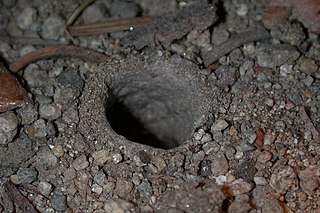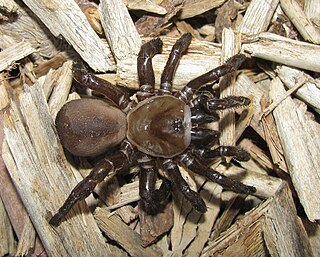
The Mygalomorphae, or mygalomorphs, are an infraorder of spiders, and comprise one of three major groups of living spiders with over 3,000 species, found on all continents except Antarctica. Many members are known as trapdoor spiders due to their creation of trapdoors over their burrows. Other prominent groups include Australian funnel web spiders and tarantulas, with the latter accounting for around one third of all mygalomorphs.

The Mesothelae are a suborder of spiders that includes a single extant family, Liphistiidae, and a number of extinct families. This suborder is thought to form the sister group to all other living spiders, and to retain ancestral characters, such as a segmented abdomen with spinnerets in the middle and two pairs of book lungs. Members of Liphistiidae are medium to large spiders with eight eyes grouped on a tubercle. They are found only in China, Japan, and southeast Asia. The oldest known Mesothelae spiders are known from the Carboniferous, over 300 million years ago.

Ctenizidae is a small family of mygalomorph spiders that construct burrows with a cork-like trapdoor made of soil, vegetation, and silk. They may be called trapdoor spiders, as are other, similar species, such as those of the families Liphistiidae, Barychelidae, and Cyrtaucheniidae, and some species in the Idiopidae and Nemesiidae. The name comes from the distinctive behavior of the spiders to construct trapdoors, and ambush prey from beneath them.

The family Cyrtaucheniidae, known as wafer-lid trapdoor spiders, are a widespread family of Mygalomorphae spiders.

Hexathelidae is a family of mygalomorph spiders. It is one of a number of families and genera of spiders known as tunnelweb or funnel-web spiders. In 2018, the family was substantially reduced in size by genera being moved to three separate families: Atracidae, Macrothelidae and Porrhothelidae.

The Eresoidea or eresoids are a group of araneomorph spiders that have been treated as a superfamily. As usually circumscribed, the group contains three families: Eresidae, Hersiliidae and Oecobiidae. Studies and reviews based on morphology suggested the monophyly of the group; more recent gene-based studies have found the Eresidae and Oecobiidae to fall into different clades, placing doubt on the acceptability of the taxon. Some researchers have grouped Hersiliidae and Oecobiidae into the separate superfamily Oecobioidea, a conclusion supported in a 2017 study, which does not support Eresoidea.
The Dictynoidea or dictynoids are a group of araneomorph spiders that have been treated as a superfamily. The composition of the group has varied. Phylogenetic studies in the 21st century have failed to confirm the monophyly of the dictynoids as originally defined.

The Haplogynae or haplogynes are one of the two main groups into which araneomorph spiders have traditionally been divided, the other being the Entelegynae. Morphological phylogenetic studies suggested that the Haplogynae formed a clade; more recent molecular phylogenetic studies refute this, although many of the ecribellate haplogynes do appear to form a clade, Synspermiata.

Atypoidea is a clade of mygalomorph spiders, one of the two main groups into which the mygalomorphs are divided. It has been treated at the rank of superfamily. It contains five families of spiders:

Atypoides is a genus of North American folding trapdoor spiders. It was first described by Octavius Pickard-Cambridge in 1883, and it has only been found in United States. It was synonymized with the genus Antrodiaetus in 2007, but was restored to its former independent status in 2019. As of November 2021, it contains only three species: A. gertschi, A. hadros, and A. riversi.

The Euctenizidae are a family of mygalomorph spiders. They are now considered to be more closely related to Idiopidae.
Entypesa is a genus of African mygalomorph spiders in the family Entypesidae. It was first described by Eugène Louis Simon in 1902. Originally placed with the curtain-web spiders, it was transferred to the funnel-web trapdoor spiders in 1985, then to the Entypesidae in 2020. It is a senior synonym of Pseudohermacha.
Pionothele is a genus of African mygalomorph spiders in the family Pycnothelidae. It was first described by William Frederick Purcell in 1902. As of June 2020 it contains 2 species, found in Namibia and South Africa: P. gobabeb, and P. straminea. Originally placed with the Ctenizidae, it was transferred to the funnel-web trapdoor spiders in 1985, then to the Pycnothelidae in 2020.

Halonoproctidae is a family of mygalomorph spiders, split off from the family Ctenizidae in 2018. Species in the family are widely distributed in North and Central America, Australasia, Asia, southern Europe and North Africa. One species is recorded from Venezuela in South America. They are relatively large, sombrely coloured spiders, that live in burrows with some kind of trapdoor.
Fossilcalcaridae is an extinct Mygalomorphae spider family in the clade Avicularioidea containing the single species Fossilcalcar praeteritus. The family genus and species were described in 2015 from a male fossil entombed in Cretaceous age Burmese amber.

Bipectina is a clade of avicularioid mygalomorph spiders first proposed by Pablo A. Goloboff in 1993, based on a morphological cladistic analysis. The clade was marked by a number of morphological features, and in particular by the presence of two rows of teeth on the superior tarsal claws of the legs of both sexes, meaning that the claws were bipectinate. The clade was supported by some subsequent analyses, although not all. A major phylogenetic study in 2020 upheld the monophyly of the clade, which contained 19 of the 25 accepted families of the Avicularioidea.

Domiothelina is a clade of avicularioid mygalomorph spiders first proposed by Robert J. Raven in 1985, based on a morphological cladistic analysis. Raven characterized the clade by a number of shared features, including the domed apical segment of the posterior lateral spinnerets. The clade has been supported to some degree by subsequent molecular analyses, although with a somewhat different composition.

Crassitarsae is a clade of avicularioid mygalomorph spiders first proposed by Robert J. Raven in 1985, based on a morphological cladistic analysis. Raven characterized the clade by a number of shared features, including the presence of some scopulae on the tarsi. The clade has been supported to some degree by subsequent molecular analyses, although with a somewhat different composition.

Theraphosoidina is a clade of avicularioid mygalomorph spiders first proposed by Robert J. Raven in 1985, based on a morphological cladistic analysis. Raven included three families: Theraphosidae, Paratropididae and Barychelidae. Subsequent molecular phylogenetic studies upheld the relationship between the Theraphosidae and Barychelidae, but found that Paratropidae fell outside the clade.

Nemesioidina is a clade of avicularioid mygalomorph spiders proposed in 2020, based on a molecular phylogenetic analysis.
















